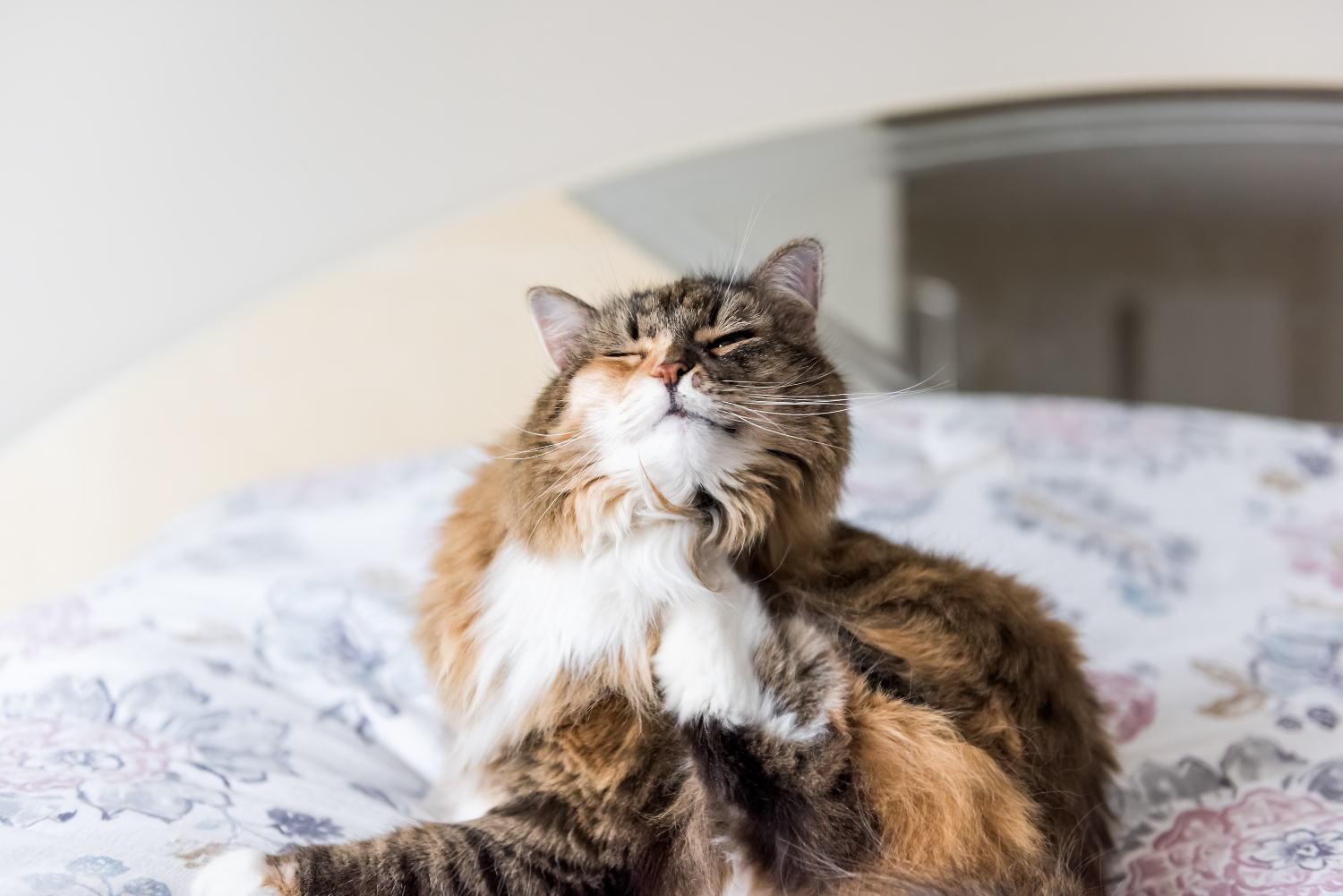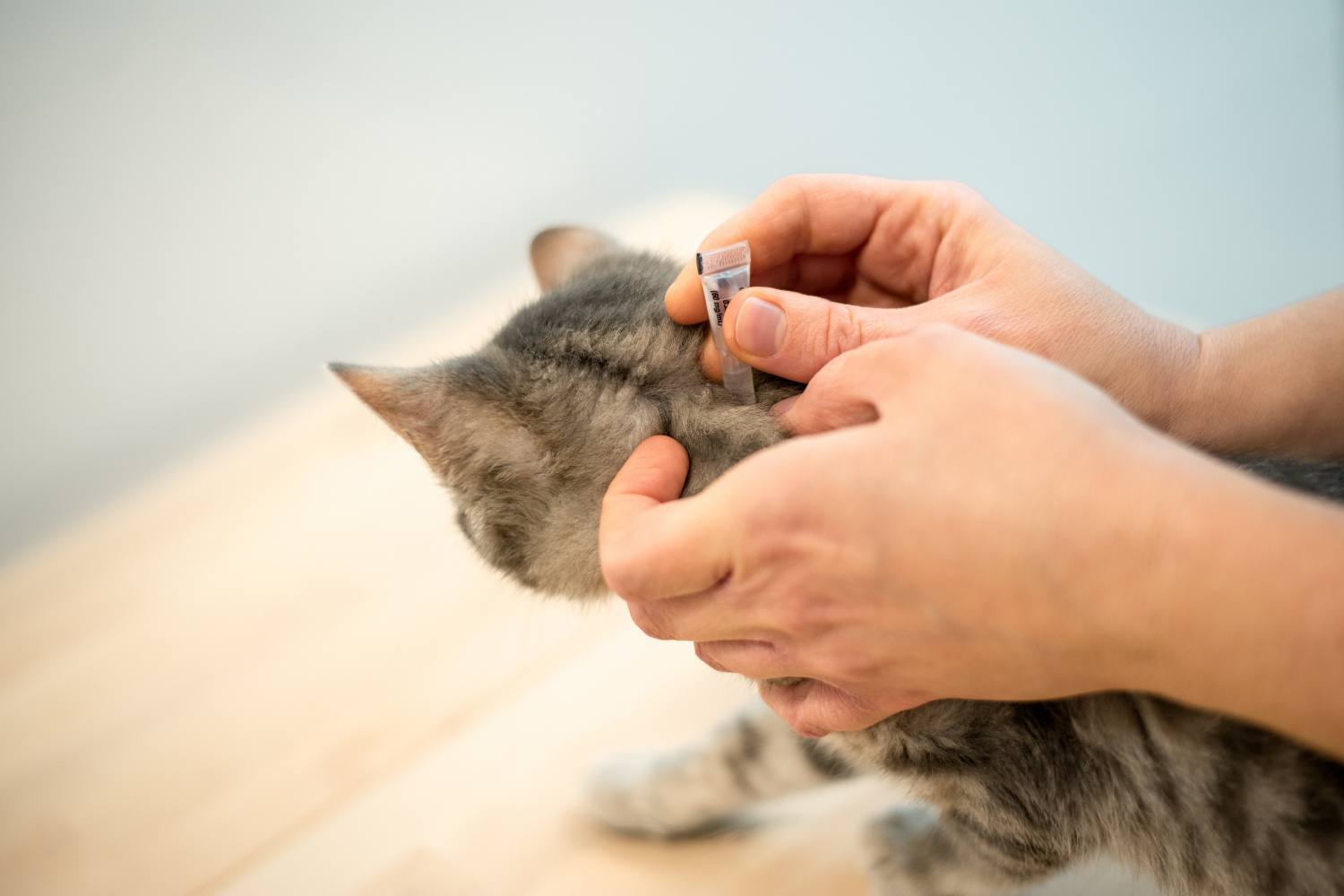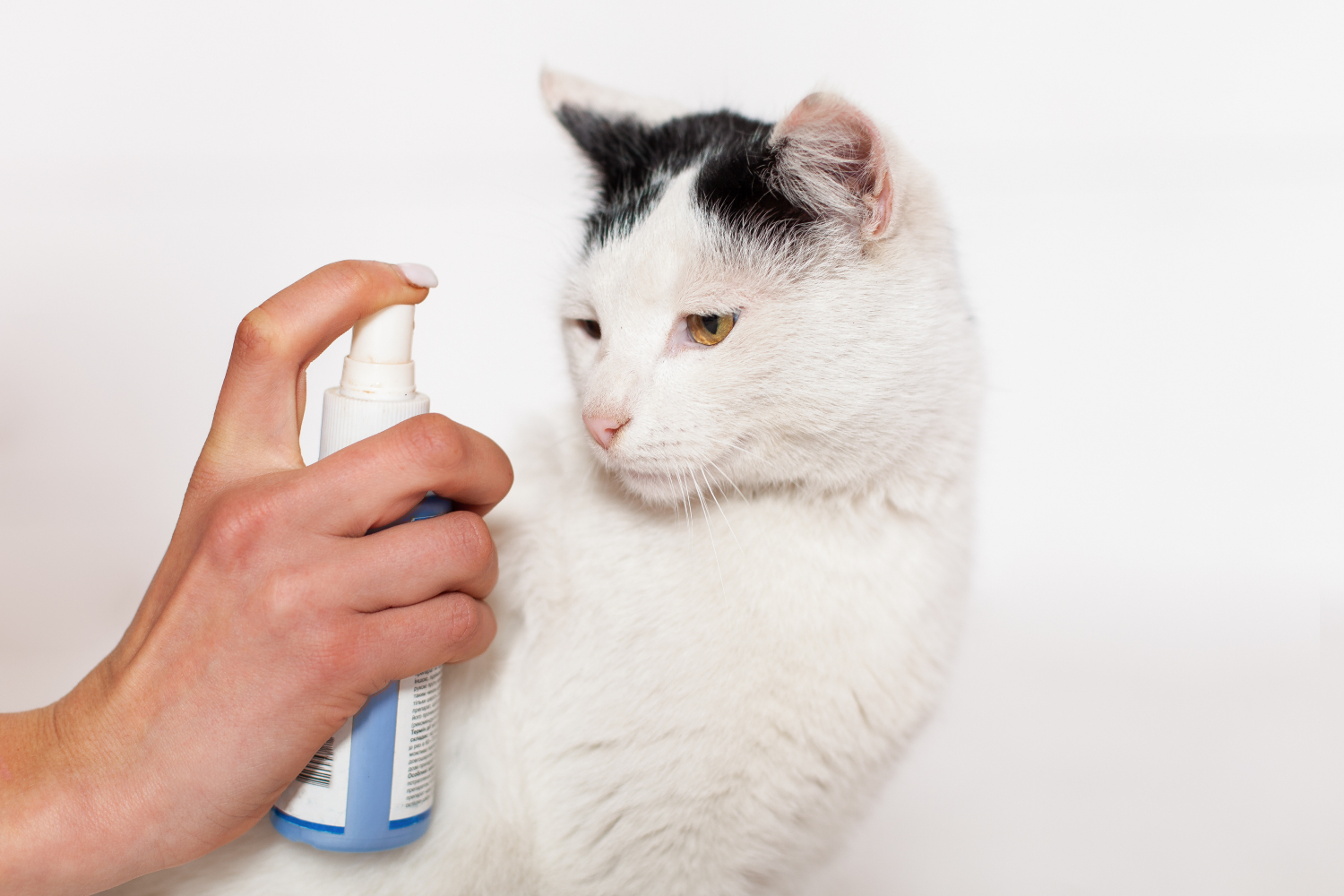
Does my cat have fleas?
19th January, 2023
Fleas! Just saying the word makes us itchy all over! So if you’ve noticed your senior cat scratching more than usual – or even the odd insect bite on your own body – those pesky parasites might have taken up residence. Here’s how to rid your ageing feline of fleas fast!
They might be tiny but they strike fear into the hearts of pet parents everywhere! Yes, we’re talking about fleas. Infuriating infestations that can quickly take over your feline and your home if you’re not careful!
In a single day, an adult female flea gets to work laying dozens of eggs onto your pet, which then get carried all over your carpets, sofas, and bedding – wherever your unsuspecting cat decides to wander. And before long, it’s not only your cat that’s scratching non-stop!
Luckily, there are ways to get rid of these fleas but, as you’ve probably guessed, prevention is usually better than the cure.
The first thing to remember is not to beat yourself up about it! Fleas are all part and parcel of cat ownership - your feline isn’t the first to get fleas and certainly won’t be the last, no matter how well you take care of them.
So, what are fleas?
Think you know all there is to know about fleas? Think again! Recent findings from the MSD Animal Health Hub found that over half (57%) of pet owners in the UK don’t know about how fleas reproduce, meaning that they’re having to deal with infestations over and over again. Not exactly how we want to be spending our spare time!
When you understand how quickly they can multiply, it makes sense to sort the problem sooner rather than later.
Notebooks at the ready - quick flea life cycle lesson coming up!
- Adult fleas have a lifespan of up to 2 years.
- Females start laying eggs within two days after they land on your pet.
- Eggs fall off your cat and end up all over your home.
- Larvae hatch in a couple of days and can be found wherever your pet likes to lie for long periods.
- Larvae can reach the pupae stage in as little as 7 days.
- Inside a cocoon, the adult flea slowly develops.
- As soon as the flea gets a signal that a potential host is nearby, they emerge and immediately attach to them – they can wait up to 2 years in the cocoon!
While it can take this long for adults to emerge, the whole lifecycle can be done and dusted in as little as two weeks. And once it’s begun and eggs are being laid daily, it’s just a matter of time before you and your pet start to feel that irritating itch!
Adult fleas have tiny mouths that are well adapted to pierce your animal’s skin and suck their blood, leaving small itchy red bumps on the surface.
As soon as you suspect fleas on your feline or in your home, you need to act quickly. And it’s a good idea to take your cat to the vet for a check-up to make sure the pests haven’t done any lasting damage.
Cats of any age can pick up fleas but older felines really need our . Killing and controlling fleas might be down to you, but with 24/7 vet video calls through your cat insurance for older cats, you can get the advice you need.
Flea bite risks for your cat
If a serious case of itching wasn’t enough for your poor pet to deal with, flea bites are also bad news for your pet’s overall health, especially when it’s getting on in years.
- Fleas feast on your pet’s blood, and when there are a lot of them, the blood loss could prove fatal particularly for older, weaker cats.
- Flea saliva causes hypersensitivity in some moggies, which can lead to an even itchier allergic reaction on their skin.
- Tapeworm eggs can infest flea larvae, which means your cat can become a host to this nasty parasite, too, if it swallows fleas when grooming. That’s why the RSPCA recommends getting your pet treated for worms as well as fleas on a regular basis.
- The pests can pass on a whole number of diseases to your cat, including an infectious bacterium called Bartonella, which can make them really poorly.
Top takeaway? Act fast if you want to stop the spread and avoid your cat becoming severely ill.
What are the signs my cat has fleas?
Are you worried your ageing cat might have finally succumbed to a family of fleas, but aren’t quite sure what to look for?
It can be tough to spot the insects themselves as cats often gobble them up while grooming. But there are some other tell-tale signs to look out for:
- Excessive scratching
- Hair loss and bald patches
- Redness on the skin
- Irritation and sores
- Black specs on the fur and skin
- Tiny insects scurrying about on your cat’s skin
- Itchy bites on your own skin
To check whether your suspicions are correct, have a good go at your pet’s fur with a fine-toothed flea comb over a white surface (like a piece of A4 paper) to make sure you can spot the evidence.
Even if you don’t come across any adults, you might spot ‘flea dirt’ – tiny black specs of poop made of digested blood. To check, add a few drops of water onto the deposits and they should slowly dissolve and leave bloody marks.
Whether you suspect a whole host of fleas or just a few, take your poor cat to the vet as soon as you can. They can suggest a treatment method to beat the pests before they get out of control.
How can I treat fleas in cats?
If you and your old feline have got a flea infestation, we bet you’re itching – quite literally – to get rid of them as soon as possible!
Here’s the good news. There are treatments and other ways you can fully eradicate the pests from your cat and your home. But the time it will take depends on how many of these critters have managed to multiply.
Here are five top tips to kill all fleas on your pet – and in your home – and make sure no larvae or pupae stick around for part 2!
- Ask your vet about the best flea products for your particular case and make sure the product is specific to cats, as some dog versions can irritate their skin. Got more than one pet? You’ll need to treat them all.
- Wash all your bedding on a high temperature and vacuum the carpets, floor, and skirting boards to eliminate fleas in all stages of the life cycle. If you want to be extra thorough, use a steam cleaner.
- Take the vacuum bag outside once you’re done. If bedding is seriously infested, it’s best to bin it.
- If you have a big infestation, you may need to use some insecticide that kills the larvae, pupae, and fleas and continues to work for another 6 months!
- If you’ve tried everything and you’re still itching, it might be time to call in professional pest controllers and let them do the dirty work for you!
Remember, flea treatments aren’t usually covered by your cat insurance for older cats as they’re seen as routine care.
Can I prevent fleas in my cat?
Yes! Prevention is definitely key here, especially if you have an old cat with a weakened immune system.
Here are some of the best ways to keep those pests at bay.
Flea treatments for cats

It’s not uncommon for pet parents to forget about flea treatments until they have an infestation, but they are an essential part of non-emergency care for your beloved moggy.
Although the treatment isn’t covered on your cat insurance for older cats, you should factor them into your pet budget from the day you bring them home.
The products are easy to administer at home, saving your furry friend a trip to the vet.
Treatments come in various forms, so you can choose one to suit your pet:
- Sprays
- Drops
- Powders
- Tablets
Give your vet a call if you need recommendations on the best product for your ageing companion. Your cat will need the treatment as often as once a month to keep fleas at bay.
Flea collar
These special collars can be highly effective in preventing an infestation on your pet. They’re super-easy to use and can last for months, but you’ll need to get a new one at least once a year.
So how do they work?
Some collars have the treatment on the outer surface, which usually doesn’t last as long as those with the product embedded inside the collar.
As your cat moves and its skin and fur rub on the surface, the treatment gets released and spreads across its body, killing any fleas in their tracks!
Regular grooming
Old cats might be less likely to groom themselves, especially if they’re old and achy, which is where you come in!
Make time for a grooming session. Grab a special flea comb (you can pick them up from the vets or pet stores) and get to work! It’s a great way to build the bond between you, too.
Brushing can improve blood circulation and prevent matting in their coat. Check out this poor cat who had 300g of matted fur removed - ouch!
Not sure your older cat likes being groomed? With cat insurance for older cats through Petwise, you can have a quick video chat with a vet to get some top tips on the best way to approach it.
Around the house
It’s not only your cat that needs regular care when it comes to preventing fleas. You also need to make sure they don’t stick around in your home if they ever get in.
- Vacuum all floors and anywhere your cat spends a lot of time, like its bed or the sofa.
- Use a steamer on carpets and upholstery now and again to make sure larvae and pupae can’t survive.
- Wash all bedding frequently, especially if your cat sleeps on your bed.
- Get environmental sprays containing insecticides. These can last up to 6 months with a single spray on a surface. Be careful which products you use and make sure they aren’t harmful to your old cat.
What other skin problems are cats prone to?
It’s not only fleas that can cause skin conditions in ageing cats. Felines are at risk of a number of issues, so why not protect them with cat insurance for older cats in the first instance.
Let’s look at the more common skin problems you might find in senior moggies.
Ear mites
Symptoms: Do you often catch your cat scratching their ears or shaking their head? They might have ear mites. Over time, this can lead to inflammation around the ear, and if not treated, a bacterial infection will start to grow.
Treatment: Your pet will need a thorough ear cleaning to get rid of wax and other debris before you can use topical medication or tablets. You might be given ear drops to help beat inflammation and infection.
Environmental and food allergies
Symptoms: Just like us, cats can be allergic to food, pollen, dust, grass, and household chemicals. Patchy fur from excessive itching and biting is a tell-tale sign.
Treatment: You need to get your cat to the vet as the treatment will depend on the cause. Food allergies must be managed by eliminating items that cause a flare up.
Your vet may put your pet on a special diet, which can be expensive. Cat insurance for older cats through Petwise includes a senior food contribution to help.
For other, more serious allergies, you might need antihistamines or steroids or to keep your cat away from the trigger indefinitely.
Mange
Symptoms: Scratching, swelling, hair loss, redness, and scabs - nasty mites that make your cat’s life hell.
Treatment: To beat mange, you’ll need topical treatment for the mites from your vet. Bedding and collars will also need to be cleaned.
Acne
Symptoms: When you get up close to your moggy, do you see blackheads around its lips and on its chin? Or maybe a red swelling? Your cat may not be a teenager, but this could be acne!
Treatment: The best way to improve this skin condition is with proper hygiene. Antibiotic wipes or topical shampoos should do the trick.
Alopecia due to stress
Symptoms: Stress in cats causes behavioural changes, like depression and sleeping more than usual – just like in humans!
Treatment: Identifying the cause of the stress is the key here. Your vet will have some top tips on how to do that.
Endocrine dermatosis
Symptoms: If your ageing moggy has itchy, dry fur with dandruff, its hormones might be all over the place due to hyperthyroidism and Cushing’s disease.
Treatment: The condition can be the result of various causes, so your vet will need to perform a few tests before coming up with an ideal treatment plan.
Ringworm
Symptoms: This nasty fungal infection causes itchy red bumps and crusty skin. You can also spot hair loss and dandruff, most noticeably on the ears.
Treatment: Medicated shampoo and antifungal medication is the go-to treatment here. Clipping their fur might also stop the infection spreading any further.
As the Bluecross us, ringworm is extremely contagious, so do everything you can to stop it spreading to your other animals. Keep your cat away from them for a few weeks until they gets the all-clear.
Injuries
Symptoms: Does your senior cat still like to patrol the neighbourhood, even though they’re getting older? Cat fights can mean injuries for your ageing moggy, and scratches and bites can become infected.
Look out for swelling and abscesses full of pus. If your feline is off its food, it might be in pain.
Treatment: Any injury like this means a visit to the vet. They’ll possibly clean and dress the area and give them pain medication before discussing further treatment.
Cat insurance for older cats protects your ageing pet in case of an accident. Although insurance doesn’t prevent or protect against accidents, it does help alleviate the financial pressure which may delay someone making an with a vet.
Protect your ageing moggy with pet insurance

Your beloved cat has spent many years by your side, so it’s only natural you would want to protect them as they enter their golden years.
As cats age, they become more prone to certain health conditions and are more likely to get into an accident – they might like to think they’re still bouncy young kittens, but they’re not as agile as they used to be!
Why choose Petwise to protect your cat?
We all want someone to look after us in our old age, don’t we? Petwise can help protect your ageing moggy through their golden years.
To find out more about our products, and how easy it is to make a claim, check out our frequently asked questions now.
With protection from Petwise, you’ll have the confidence to give an ageing cat a loving, forever home. What are you waiting for? Get a quick quote today.